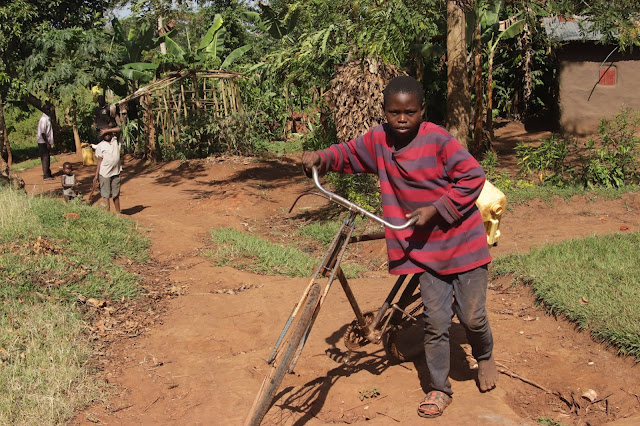Day 11 - The source of the Nile
90 days, that is how long the water of the longest river
in the world, the Nile, flows from the starting point in Lake Victoria to the estuary
in the Mediterranean. 90 days in which the water gives life to places where
otherwise no life would be. 90 days also in which the water witnesses life
along the Nile. From the moment the water leaves Lake Victoria, it starts a
long journey through different countries with spectacular landscapes and
ancient civilizations. Elegantly swaying papyrus plants along the bank say
goodbye to the Nile, as it were.
In this first part, the White Nile is also
called Victoria Nile after the large lake from which it forms the outflow. The
name White Nile comes from the white foam heads that are on the raging water.
We can certainly call the water furious in this part. The Nile forms a wide
river with many rapids and mini waterfalls, but also with the most powerful
waterfall in the world, Murchison Falls. Perfect for the adventurous tourists
to find what they are looking for here. In Uganda, the river further cools and
quenches the thirst of waterbucks, Nile crocodiles, hartebeasts, giraffes,
elephants and other members of the Big Five. The Nile is the only water source
and therefore has a huge attraction to the wildlife population. Hippos also
called Nile horses, have not stolen their name. Thousands of them find their
home here. During the day they keep their heads cool in the fresh water, at
night they find their food on the green banks.
From Lake Albert, the Nile changes its nickname and is called
the Albert Nile. The Nile is not only a source of water, but also a source of
food. Hundreds of fishermen venture out on the river every day to catch the
popular Nile perch.
In South Sudan, the Nile turns into a huge swamp and in Sudan,
the river is a paradise for playing and screaming children and the washing place for the mother
of the family. The water also provides irrigation of the plantations along the
riverbanks. It is thanks to the frequent flooding of the Nile that the banks
are so fertile. Palm trees provide food and shade along the waterfront. The
Nile is the most important lifeline of North Africa. Due to the enormous heat,
a lot of water also evaporates from the river. Fortunately, the main tributary,
the Blue Nile that wells in Ethiopia, provides a necessary addition to the
water level. Near the Sudanese capital of Karthoum, the White and Blue Nile
flow together. The Nile still has a difficult way to go. Because next the Nile
winds like a lifeline through a sea of sand. In that immense desert, the
Sahara, Egypt is sometimes called the ‘Gift of the Nile’. One of the most
powerful and longest civilizations ever, Ancient Egypt, lasted no less than
3,000 years. In the land of the Pharaohs, the waters of the Nile carry along the remnants of the ancient history of
the country. Temples, pyramids and past glories are still the silent witnesses
of a once high civilization. Sailing down the Nile is therefore the perfect way
for tourists from all over the world to view these beautiful pearls in an easy
way. What an amazing journey the water
makes along the northeast of the African continent before joining the blue
waters of the Mediterranean in the estuary of the Nile. A journey of more than
6,800 km. The Ancient Egyptians called the Nile ‘the Mother of the World’. And
when you consider that the Nile, like mothers, gives life, that is not said too
much.
Over the years, the source of the Nile has been a hot
topic of discussion. After all, the origin of the Nile must be a source
powerful enough to supply the longest river in the world. It has long been
believed that the Nile wells in the north of Lake Victoria, at Ripon Falls,
where the water is forced through a narrow opening to form the outflow of the
Nile. In addition, reference is also made to other tributaries or rivers that
feed Lake Victoria and are thus the source of the source, the absolute zero.
But these are like small currents, not really powerful enough to be recorded as
a source. They are source rivers, rather than the real source. Lake Victoria
is, as the largest lake in Africa, certainly a huge source of power. Besides,
other theories are not generally accepted by science. And my favorite explorer
Dr. Livingstone could not prove otherwise. That's why I say to Rippon Falls, ‘The
source of the Nile, I presume’?
Ripon Falls is located in the city of Jinja, a relief
from the chaos and overcrowding of capital Kampala. The proximity of the Nile
with its rapids ensures that the city is popular with sports enthusiasts and
adventurers. Kayaking and rafting are extremely polupular here. It is an ideal city to get
started on a souvenir hunt or to sit down on a terrace, having a cool drink and
enjoying people go by. And that after discovering the source of the Nile here
;-).
.JPG)






Comments
Post a Comment